According to the Valley of Fire State Park website evidence of human occupation inside the present park boundaries dates back to the Basketmaker Culture 2,500 years ago. When the nearby ghost town of St. Thomas was settled by the Mormons in 1865 they documented Paiutes living in area.
What is now Valley of Fire State Park lies in a gap in the terrain connecting Moapa Valley southwest towards Las Vegas Valley. This gap made the vicinity of Valley of Fire State Park a natural corridor of travel through the Mojave Desert. Although the area around Valley of Fire State Park was part of the Old Spanish Trail it wasn't until the formation of the Mormon Road that it became a regular corridor of travel by European settlers.
The Mormon Road was scouted by a party led by Jefferson Hunt which were looking for a supply route from Salt Lake City to Southern California through 1847-1848. The Mormon Road south from Utah passed through New Mexico Territory into California where descended through Cajon Pass via Coyote Canyon (modern Crowder Canyon) and Cajon Canyon into San Bernardino Valley. The Mormon Road was later reorganized and improved into the Los Angeles-Salt Lake Trail by 1855 which can be seen passing through New Mexico Territory on the 1857 Britton & Rey's Map of California.
Nevada became a State during October of 1864 but did not include much of what was is now Clark County. Much of modern Clark County became part of Pah-Ute County of Arizona Territory in 1865. Much of Pah-Ute County of Arizona Territory was transferred to the State of Nevada in January of 1867 which included what is now Valley of Fire State Park. The Los Angeles-Salt Lake Trail can seen passing through Lincoln County, Nevada and the vicinity of modern Valley of Fire State Park on the 1873 Bancroft's Map of California, Nevada, Utah and Arizona. Clark County wouldn't be spun off from Lincoln County until 1909.
According to the Valley of Fire State Park website a primitive automotive road was constructed immediately south of sandstone formations in 1912 towards Las Vegas Valley. This early automotive road was incorporated into the Arrowhead Trail when the Arrowhead Trails Association was incorporated during December of 1916. The 1917 Arrowhead Trail Map shows the namesake Auto Trail heading southwest from St. Thomas via what is now Valley of Fire State Park towards Las Vegas via Griffith Summit of the Muddy Mountains.
The 1919 Nevada Department of Highways Map shows the Arrowhead Trail heading southwest from St. Thomas towards Las Vegas through what is now Valley of Fire State Park as a primary highway. The Arrowhead Trail was designated as Nevada State Route 6 ("NV 6") from the Arizona State Line southwest to Las Vegas by the Nevada Legislature in 1919. Note; the Arrowhead Trail originally followed NV 5 south from Las Vegas towards Searchlight and the California State Line.
A driver can be seen heading north on the Arrowhead Trail in the 1920s with what is now Valley of Fire of State Park in the background. Valley of Fire obtained it's named during the 1920s when a writer from AAA coined it.
The 1924 Rand McNally Map of California and Nevada shows the Arrowhead Trail in addition to Evergreen National Highway traveling through Valley of Fire. The Arrowhead Trail and Evergreen National Highway can be seen climbing the 3,500 foot Griffith Summit southwest of Valley of Fire.
8,760 acres of Federal Land in Valley of Fire was purchased from by the State of Nevada in 1931 with the intention of creating a State Park. The Civilian Conservation Corps began construction of numerous facilities and infrastructure which would facilitate a State Park at Valley of Fire. The former Arrowhead Trail over Griffith Summit can be seen connecting US 91/NV 6 in Las Vegas northeast to Valley of Fire towards NV 12 and St. Thomas on the 1931 Clason's Road Map of Nevada. This road over Griffith Summit is shown as Valley of Fire Highway.
A Clark County Road approximating modern Valley of Fire Road first appears between the rail siding of Crystal on US 91/NV 6 east through Valley of Fire to NV 12 near St. Thomas on the 1933 Official Road Map of Nevada.
The construction of Valley of Fire Road in 1930 as seen on the Valley of Fire State Park website.
The 1937 Gousha Road Map of Nevada shows NV 40 in clear detail along with where the Arrowhead Trail originally diverted southwest towards Las Vegas at Piute Point.
During the 1976 Nevada State Highway Renumbering NV 40/Valley of Fire Road were designated as part of NV 169. Valley of Fire appears signed as NV 40 but legislatively designated NV 169 on the 1978-79 Official Road Map of Nevada.
NV 169 is shown truncated to the boundary of Lake Mead National Recreation Area on the 1982 Official Road Map of Nevada which left Valley of Fire Road without a State Highway designation.
During June of 1995 the 10.5 miles of Valley of Fire Road within the boundary of Valley of Fire State Park were designated as a Nevada Scenic Byway. This segment of Valley of Fire Road is seen with the Nevada Scenic Byway designation on the 2017-18 Official Road Map of Nevada.
Part 2; visiting Valley of Fire State Park, Valley of Fire Road and White Domes Road
Valley of Fire Road westbound begins from NV 169/North Shore Road at the Boundary of the Lake Mead National Recreation Area near Old St. Thomas Road/former NV 12. Valley of Fire State Park is signed as 1 mile away whereas as Interstate 15 is signed 26 miles to the west.
As Valley of Fire Road continues westward it enters Valley of Fire State Park. The boundary of Valley of Fire State Park is obvious due to the asphalt quality changing and a "Begin Scenic Byway" sign assembly being present.
As Valley of Fire Road enters Valley of Fire State Park it initially follows the path of the Arrowhead Trail westward to the east entrance station.
At the east entrance station Valley of Fire Road diverges from the former alignment of the Arrowhead Trail. The former Arrowhead Trail has been incorporated into the Old Arrowhead Road Trail which can be seen on as a major trail on the Valley of Fire State Park brochure.
A historic marker pertaining to the Arrowhead Trail can be found on Valley of Fire Road west of the east entrance station. The historic marker can be found where Valley of Fire Road passes over the Old Arrowhead Road Trail.
The Arrowhead Trail Historic Marker courtesy of hmdb.org.
The Arrowhead Trail Historic Marker reads as follows:
"Las Vegans claimed to be the originators of this all-weather route between Los Angels and Salt Lake City. From the beginning, the Arrowhead Trail was a "grass roots" effort including promotion by various chambers of commerce and volunteer construction by local citizens. However, it was Charles H. Bigelow, from Los Angeles, who gave it great publicity. During 1915 & 1916 he drove the entire route many times in his twin-six Packard "Cactus Kate."
West of the Arrowhead Trail Historic Marker the path of Valley of Fire Road continues through the Seven Sisters formation.






























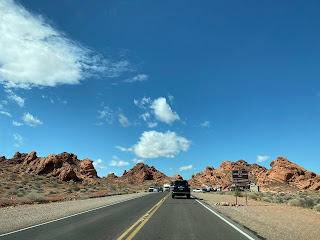











































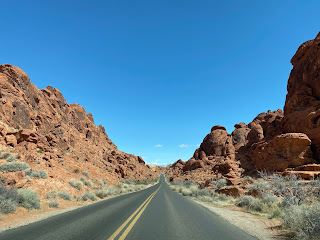



























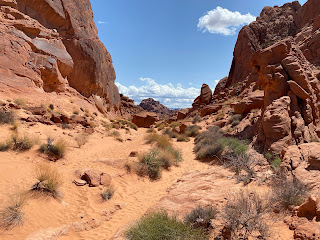



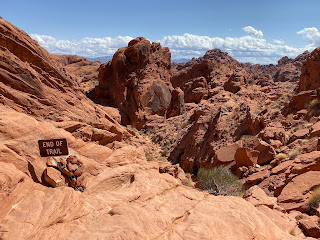





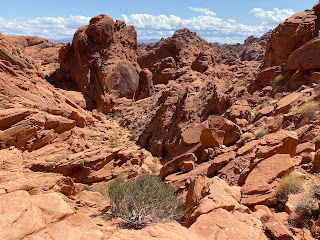




















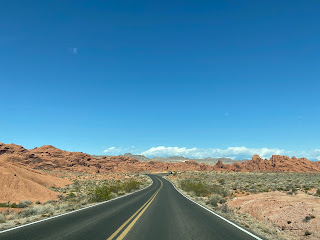





















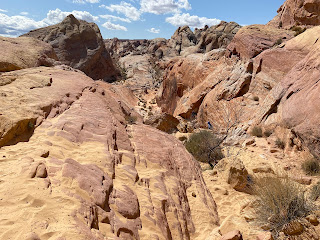




















































































Comments